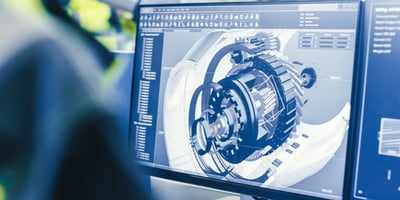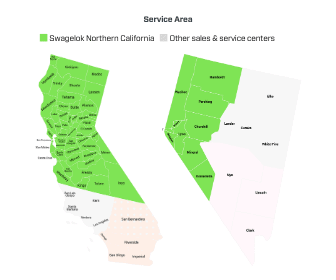Selecting a Mechanical Seal Support Flushing Plan With Confidence
by Malik Durojaiye, on 3/11/21 8:45 AM
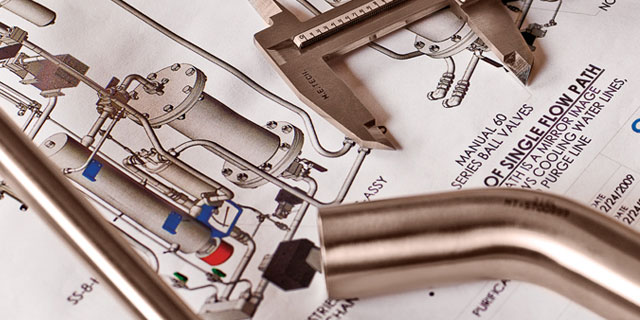
Few industries in Northern California are fortunate enough to have all the in-house expertise and resources you need to confidently select the right mechanical seal support flushing plan for a specific pumping process. The reason? The numerous factors to consider when designing and assembling a mechanical seal support flushing plan. There are more than three dozen distinct plans listed in the API 682 Standard. That’s not an overwhelming number, and the standard provides details for each of the configurations, but each of those plans has a range of options to consider. The final configuration of any plan will depend on:
- Process conditions such as type and composition of the process fluid, temperature, pumping pressure, pumping cycles, and BEP for the specific pump
- Existing or planned infrastructure surrounding the pump
- Availability of plant utilities—water, nitrogen, flush fluids
- Current seal support system component technology
- Best practices for seal support system design and assembly
That’s quite a few factors to consider, but the selection process becomes a bit simpler when you classify the mechanical seal support systems into three categories—process side, between seal, and atmospheric side. A quick explanation of each will help you understand the general capabilities of the seal support system categories and the typical use cases.
Process Side Mechanical Seal Support Flushing Plans
The flow: Process side mechanical seal support systems use the fluid being pumped to maintain the required lubrication, pressure, and temperature for the mechanical seal. These plans circulate process fluids in two ways (1) from the pump discharge to the seal chamber and from the seal chamber to the pump suction (2) from the pump discharge to the seal chamber and from there to the pump suction.
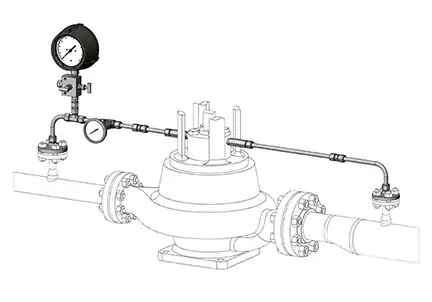
API Plan 14 recirculates process fluid from pump discharge into the seal chamber and from the seal chamber to the pump suction to continuously vent the seal chamber and provide higher cooling capacity.
Use cases: More than ten different mechanical seal support flushing plans fall into this classification. These plans are commonly used for non-hazardous, non-toxic pumping. Process fluids can range from low-temperature plant water to hot water services 80°C (176°F) to boiler feeds. Highly viscous fluids that tend to polymerize and fluids with suspended solids are also candidates for process side plans.
Between Seals (Dual Seals) Mechanical Seal Support Flushing Plans
The Flow: The between seal arrangement has a “primary” (inboard) seal and a “secondary” (outboard) seal. This design offers significantly better protection against process fluid leakage to the atmosphere. Barrier (pressurized) or buffer (unpressurized) buffer fluid is delivered to the seal chamber from an external source such as a reservoir or plant nitrogen. These fluids are circulated with the aid of a pumping ring or an external pump attached to the reservoir.
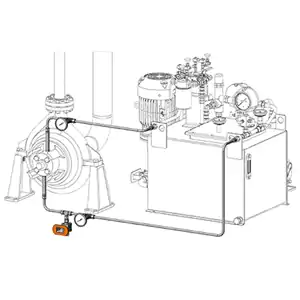
API Plan 55 circulates buffer fluid to and from the seal chamber via a pump located on an external reservoir. Optional filters, coolers, and components are available for this custom-engineered system.
Use cases: Dirty, contaminated, abrasive, hazardous, toxic, or polymerizing process fluids where leakage to the atmosphere presents an environmental or operational risk.
Atmospheric Side Mechanical Seal Support Flushing Plans
The Flow:
A pressureless or low-pressure quench (typically water, steam, or plant nitrogen) is delivered from an external source to the atmospheric side of a single mechanical seal. The quench cools the mechanical seal to prevent solids formation, crystalization, or coking on the atmospheric side of the seal faces.
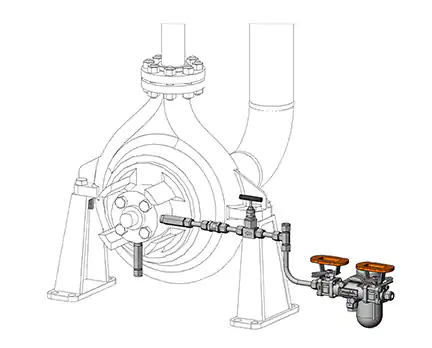
API Plan 62 delivers quench fluid (nitrogen, clean water, or stream) to the atmospheric side of the seal.
Use cases: Hot hydrocarbon services, cryogenic processes, fluids that condense when exposed to the atmosphere, and caustic or salt services.
Guidance in Selecting Components and Options
These plans may include a range of components and design options to configure the seal support system to the specific needs of the pumping process. Instrumentation such as pressure and temperature gauges and flowmeters monitor fluid flows and alert to any changes that could result in less than ideal mechanical seal conditions. Strainers and filters remove contaminants and particulates that damage seal faces from process fluid before circulating it through the seal chamber. Coolers and heat exchangers maintain the required temperature of process and barrier fluids circulating through the seal chamber. Nitrogen, bladder accumulators, and piston accumulators are used to maintain the proper barrier fluid pressure.
The design of a mechanical seal support flushing plan requires more than just selecting one of the API 682 Plans from a catalog. To obtain the maximum value from your investment, rely on the guidance of an experienced fluid systems Field Engineer who can provide a thorough on-site or virtual assessment of the pumping process and surrounding infrastructure.
The assessment will include characteristics of the process fluid, type of mechanical seal selected for the pump, the existing or planned infrastructure surrounding the pump, access to plant utilities, and safety and environmental requirements per Cal/OHSA and/or BAAQMD. Taking those factors into consideration, the Field Engineer will then recommend the mechanical seal support flushing plan that best addresses those pumping conditions. Detailed design specifications and a bill of materials will be included for your review and approval.
Confidently Select the Optimum Plan with Expert Guidance
For well over 50 years Swagelok has worked closely with Northern California Bay Area process industries to confidently select mechanical seal support flushing plans. Our locally based Field Engineers and certified technicians provide field verification of your seal support requirements, designs based on best practices gained from global experience.
Swagelok is ISO 9001 certified and our technicians fabricate and thoroughly test your systems prior to delivery. And to give you added confidence regarding the quality of our design and fabrication process, Swagelok’s Lifetime Warranty is the industry's best.
To learn how Swagelok Northern California's local experience and global expertise can help you confidently select the mechanical seal support flushing plan for your pumping requirements, contact our team today by calling 510-933-6200.
-1.jpg?width=192&name=image8%20(1)-1.jpg) About Malik Durojaiye | Field Engineer, Assembly Services
About Malik Durojaiye | Field Engineer, Assembly Services
Malik Durojaiye began his Swagelok career in 2019 as a Custom Solutions Engineer in our Assembly Services group. Prior to Swagelok, Malik developed as a design engineer as well as a manufacturing engineer for 6 years serving Kentucky and California with Altec Industries; a leading provider of products and services to the electric utility, telecommunications, tree care, lights and signs, and contractor markets.



/Digital%20montage%20(1).jpg?width=1920&name=Digital%20montage%20(1).jpg)
